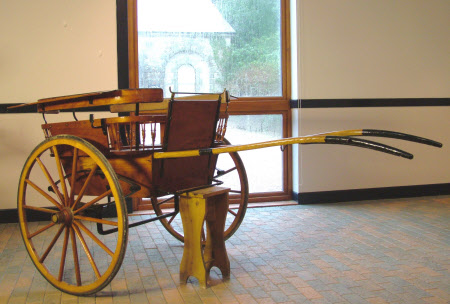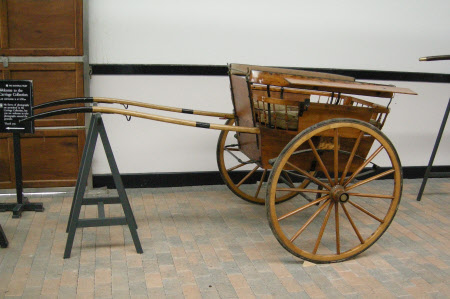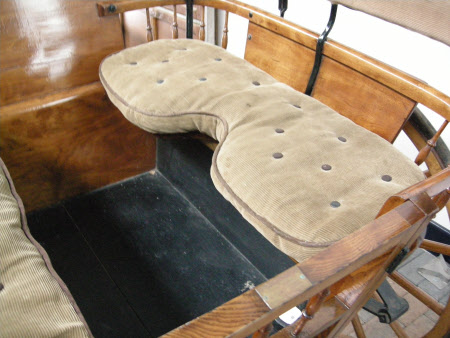Governess car
H. Sanders and Son
Category
Carriages & other vehicles
Date
1900
Materials
Varnished wood body with cord upholstery and two painted rubber shod wheels.
Measurements
124 x 148 x 123.5cm (4ft 3/4in x 4ft 10 1/4in x 4ft 2/3in)
Place of origin
Hitchin
Order this imageCollection
National Trust Carriage Museum
NT 272941.1
Caption
Small and informal carriages were often used by the lady of the house. As the name suggests, it was often used by a governess or mother to take the children out for a drive. Carriages like this are also called tub carts, having a deep tub-shaped body with access through a door at the back, and seats each side. These carriages were always owner driven; the driver sitting uncomfortably on a diagonal in the back right-hand corner.
Summary
Governess Car built by Sanders and Son of Hitchin circa 1900. Governess Car (two wheels) for a single pony or donkey. This carriage has a spindle back and is sprung on elliptic springs. There are two fawn coloured corded buttoned cushions. Natural wood varnished body with yellow wheels. Gift of Mrs. Swannack and used by her in the 1950's.
Full description
Built in the early 1900s by R.E. Sanders & Sons Ltd, Hitchin, Hertfordshire, this informal little carriage was given to the National Trust by Mrs. Swannack. Governess cars, sometimes called tub carts for obvious reasons, have a deep tub-shaped body with access through a door at the back, and seats each side, to carry four. They were often used by a governess (hence the name), or possibly a mother, to take the children out for a drive. She would drive sitting diagonally in the back right-hand corner. Although the seat and the cushion on the right hand side have been shaped for this purpose, this would still have been difficult and uncomfortable. Only the quietest pony, or sometimes a donkey, was suitable to be driven to a governess car, not only because of the awkward driving position, but because it was difficult to get out quickly and run to his head if she needed to. The cranked axle allows the body to be mounted lower, dropping the centre of gravity and making it difficult to overturn.
Marks and inscriptions
On front nearside axle cap.: SANDERS & SONS LTD HITCHIN On front offside axle cap.: SANDERS & SONS LTD HITCHIN On rear nearside axle cap.: SANDERS & SONS LTD HITCHIN On rear offside axle cap.: SANDERS & SONS LTD HITCHIN On brass plate on top rail of door.: R.E.SANDERS & SONS LTD Coach Builders HITCHIN HERTS “The Empress Car” Stamped on the door sill.: 10422(?) On front nearside axle components. : R3 MADE FOR SANDERS HITCHIN On front offside axle components.: R3 MADE FOR SANDERS HITCHIN On rear nearside axle components.: R3 MADE FOR SANDERS HITCHIN On rear offside axle components.: R3 MADE FOR SANDERS HITCHIN
Makers and roles
H. Sanders and Son, coach builder



